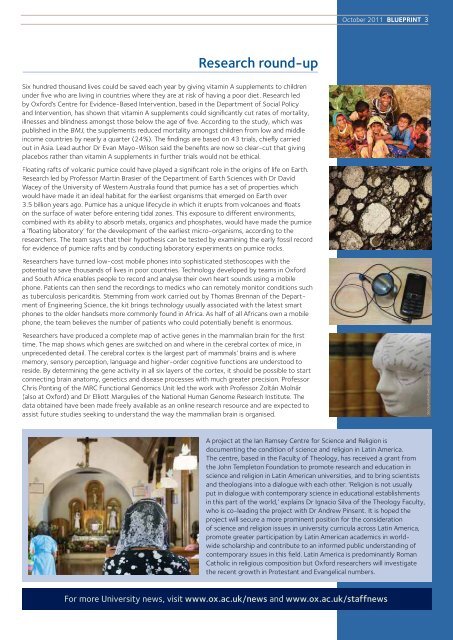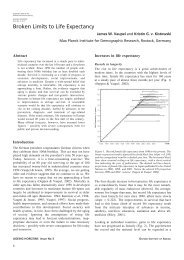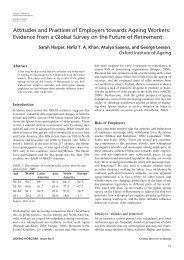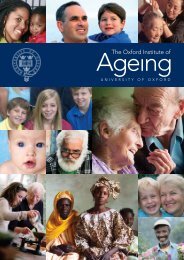Blueprint - October 2011 - Oxford Institute of Ageing - University of ...
Blueprint - October 2011 - Oxford Institute of Ageing - University of ...
Blueprint - October 2011 - Oxford Institute of Ageing - University of ...
Create successful ePaper yourself
Turn your PDF publications into a flip-book with our unique Google optimized e-Paper software.
<strong>October</strong> <strong>2011</strong> BLUEPRINT 3<br />
Research round-up<br />
Six hundred thousand lives could be saved each year by giving vitamin A supplements to children<br />
under five who are living in countries where they are at risk <strong>of</strong> having a poor diet. Research led<br />
by <strong>Oxford</strong>’s Centre for Evidence-Based Intervention, based in the Department <strong>of</strong> Social Policy<br />
and Intervention, has shown that vitamin A supplements could significantly cut rates <strong>of</strong> mortality,<br />
illnesses and blindness amongst those below the age <strong>of</strong> five. According to the study, which was<br />
published in the BMJ, the supplements reduced mortality amongst children from low and middle<br />
income countries by nearly a quarter (24%). The findings are based on 43 trials, chiefly carried<br />
out in Asia. Lead author Dr Evan Mayo-Wilson said the benefits are now so clear-cut that giving<br />
placebos rather than vitamin A supplements in further trials would not be ethical.<br />
Floating rafts <strong>of</strong> volcanic pumice could have played a significant role in the origins <strong>of</strong> life on Earth.<br />
Research led by Pr<strong>of</strong>essor Martin Brasier <strong>of</strong> the Department <strong>of</strong> Earth Sciences with Dr David<br />
Wacey <strong>of</strong> the <strong>University</strong> <strong>of</strong> Western Australia found that pumice has a set <strong>of</strong> properties which<br />
would have made it an ideal habitat for the earliest organisms that emerged on Earth over<br />
3.5 billion years ago. Pumice has a unique lifecycle in which it erupts from volcanoes and floats<br />
on the surface <strong>of</strong> water before entering tidal zones. This exposure to different environments,<br />
combined with its ability to absorb metals, organics and phosphates, would have made the pumice<br />
a ‘floating laboratory’ for the development <strong>of</strong> the earliest micro-organisms, according to the<br />
researchers. The team says that their hypothesis can be tested by examining the early fossil record<br />
for evidence <strong>of</strong> pumice rafts and by conducting laboratory experiments on pumice rocks.<br />
Researchers have turned low-cost mobile phones into sophisticated stethoscopes with the<br />
potential to save thousands <strong>of</strong> lives in poor countries. Technology developed by teams in <strong>Oxford</strong><br />
and South Africa enables people to record and analyse their own heart sounds using a mobile<br />
phone. Patients can then send the recordings to medics who can remotely monitor conditions such<br />
as tuberculosis pericarditis. Stemming from work carried out by Thomas Brennan <strong>of</strong> the Department<br />
<strong>of</strong> Engineering Science, the kit brings technology usually associated with the latest smart<br />
phones to the older handsets more commonly found in Africa. As half <strong>of</strong> all Africans own a mobile<br />
phone, the team believes the number <strong>of</strong> patients who could potentially benefit is enormous.<br />
Researchers have produced a complete map <strong>of</strong> active genes in the mammalian brain for the first<br />
time. The map shows which genes are switched on and where in the cerebral cortex <strong>of</strong> mice, in<br />
unprecedented detail. The cerebral cortex is the largest part <strong>of</strong> mammals’ brains and is where<br />
memory, sensory perception, language and higher-order cognitive functions are understood to<br />
reside. By determining the gene activity in all six layers <strong>of</strong> the cortex, it should be possible to start<br />
connecting brain anatomy, genetics and disease processes with much greater precision. Pr<strong>of</strong>essor<br />
Chris Ponting <strong>of</strong> the MRC Functional Genomics Unit led the work with Pr<strong>of</strong>essor Zoltán Molnár<br />
(also at <strong>Oxford</strong>) and Dr Elliott Margulies <strong>of</strong> the National Human Genome Research <strong>Institute</strong>. The<br />
data obtained have been made freely available as an online research resource and are expected to<br />
assist future studies seeking to understand the way the mammalian brain is organised.<br />
A project at the Ian Ramsey Centre for Science and Religion is<br />
documenting the condition <strong>of</strong> science and religion in Latin America.<br />
The centre, based in the Faculty <strong>of</strong> Theology, has received a grant from<br />
the John Templeton Foundation to promote research and education in<br />
science and religion in Latin American universities, and to bring scientists<br />
and theologians into a dialogue with each other. ‘Religion is not usually<br />
put in dialogue with contemporary science in educational establishments<br />
in this part <strong>of</strong> the world,’ explains Dr Ignacio Silva <strong>of</strong> the Theology Faculty,<br />
who is co-leading the project with Dr Andrew Pinsent. It is hoped the<br />
project will secure a more prominent position for the consideration<br />
<strong>of</strong> science and religion issues in university curricula across Latin America,<br />
promote greater participation by Latin American academics in worldwide<br />
scholarship and contribute to an informed public understanding <strong>of</strong><br />
contemporary issues in this field. Latin America is predominantly Roman<br />
Catholic in religious composition but <strong>Oxford</strong> researchers will investigate<br />
the recent growth in Protestant and Evangelical numbers.<br />
For more <strong>University</strong> news, visit www.ox.ac.uk/news and www.ox.ac.uk/staffnews




![ORAL PRESENTATIONS [pdf] - Oxford Institute of Ageing](https://img.yumpu.com/37918222/1/184x260/oral-presentations-pdf-oxford-institute-of-ageing.jpg?quality=85)





